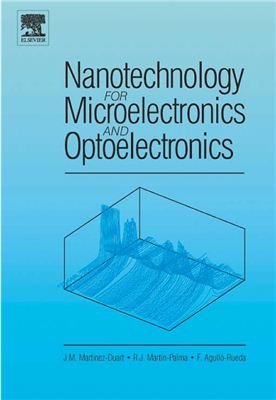Elsevier, 2006, 301p.
Preface
About the Authors
Acknowledgements
Structure of the Book
Mesoscopic Physics and Nanotechnologies
Outlook of the book
Trends in nanoelectronics and optoelectronics
Characteristic lengths in mesoscopic systems
Quantum mechanical coherence
Quantum wells, wires, and dots
Density of states and dimensionality
Semiconductor heterostructures
Quantum transport
References
Further Reading
Problems
Survey of Solid State Physics
Introduction
Short review of quantum mechanics
Free electron model of a solid Density of states function
Bloch theorem
Electrons in crystalline solids
Dynamics of electrons in bands
Lattice vibrations
Phonons
References
Further Reading
Problems
Review of Semiconductor Physics
Introduction
Energy bands in typical semiconductors
Intrinsic and extrinsic semiconductors
Electron and hole concentrations in semiconductors
Elementary transport in semiconductors
Degenerate semiconductors
Optical properties of semiconductors
References
Further Reading
Problems
The Physics of Low-Dimensional Semiconductors
Introduction
Basic properties of two-dimensional semiconductor nanostructures
Square quantum well of ?nite depth
Parabolic and triangular quantum wells
Quantum wires
Quantum dots
Strained layers
Effect of strain on valence bands
Band structure in quantum wells
Contents
Excitonic effects in quantum wells
References
Further Reading
Problems
Semiconductor Quantum Nanostructures and Superlattices
Introduction
MOSFET structures
Heterojunctions
Quantum wells
Superlattices
References
Further Reading
Problems
Electric Field Transport in Nanostructures
Introduction
Parallel transport
Perpendicular transport
Quantum transport in nanostructures
References
Further Reading
Problems
Transport in Magnetic Fields and the Quantum Hall Effect
Introduction
Effect of a magnetic ?eld on a crystal
Low-dimensional systems in magnetic ?elds
Density of states of a D system in a magnetic ?eld
The Aharonov–Bohm effect
The Shubnikov–de Haas effect
The quantum Hall effect
References
Further Reading
Problems
Optical and Electro-optical Processes in Quantum Heterostructures
Introduction
Optical properties of quantum wells and superlattices
Optical properties of quantum dots and nanocrystals
Electro-optical effects in quantum wells Quantum con?ned Stark
effect
Electro-optical effects in superlattices Stark ladders and Bloch
oscillations
References
Further Reading
Problems
Electronic Devices Based on Nanostructures
Introduction
MODFETs
Heterojunction bipolar transistors
Resonant tunnel effect
Hot electron transistors
Resonant tunnelling transistor
Single electron transistor
References
Contents
Further Reading
Problems
Optoelectronic Devices Based on Nanostructures
Introduction
Heterostructure semiconductor lasers
Quantum well semiconductor lasers
Vertical cavity surface emitting lasers (VCSELs)
Strained quantum well lasers
Quantum dot lasers
Quantum well and superlattice photodetectors
Quantum well modulators
References
Further Reading
Problems
Index
Preface
About the Authors
Acknowledgements
Structure of the Book
Mesoscopic Physics and Nanotechnologies
Outlook of the book
Trends in nanoelectronics and optoelectronics
Characteristic lengths in mesoscopic systems
Quantum mechanical coherence
Quantum wells, wires, and dots
Density of states and dimensionality
Semiconductor heterostructures
Quantum transport
References
Further Reading
Problems
Survey of Solid State Physics
Introduction
Short review of quantum mechanics
Free electron model of a solid Density of states function
Bloch theorem
Electrons in crystalline solids
Dynamics of electrons in bands
Lattice vibrations
Phonons
References
Further Reading
Problems
Review of Semiconductor Physics
Introduction
Energy bands in typical semiconductors
Intrinsic and extrinsic semiconductors
Electron and hole concentrations in semiconductors
Elementary transport in semiconductors
Degenerate semiconductors
Optical properties of semiconductors
References
Further Reading
Problems
The Physics of Low-Dimensional Semiconductors
Introduction
Basic properties of two-dimensional semiconductor nanostructures
Square quantum well of ?nite depth
Parabolic and triangular quantum wells
Quantum wires
Quantum dots
Strained layers
Effect of strain on valence bands
Band structure in quantum wells
Contents
Excitonic effects in quantum wells
References
Further Reading
Problems
Semiconductor Quantum Nanostructures and Superlattices
Introduction
MOSFET structures
Heterojunctions
Quantum wells
Superlattices
References
Further Reading
Problems
Electric Field Transport in Nanostructures
Introduction
Parallel transport
Perpendicular transport
Quantum transport in nanostructures
References
Further Reading
Problems
Transport in Magnetic Fields and the Quantum Hall Effect
Introduction
Effect of a magnetic ?eld on a crystal
Low-dimensional systems in magnetic ?elds
Density of states of a D system in a magnetic ?eld
The Aharonov–Bohm effect
The Shubnikov–de Haas effect
The quantum Hall effect
References
Further Reading
Problems
Optical and Electro-optical Processes in Quantum Heterostructures
Introduction
Optical properties of quantum wells and superlattices
Optical properties of quantum dots and nanocrystals
Electro-optical effects in quantum wells Quantum con?ned Stark
effect
Electro-optical effects in superlattices Stark ladders and Bloch
oscillations
References
Further Reading
Problems
Electronic Devices Based on Nanostructures
Introduction
MODFETs
Heterojunction bipolar transistors
Resonant tunnel effect
Hot electron transistors
Resonant tunnelling transistor
Single electron transistor
References
Contents
Further Reading
Problems
Optoelectronic Devices Based on Nanostructures
Introduction
Heterostructure semiconductor lasers
Quantum well semiconductor lasers
Vertical cavity surface emitting lasers (VCSELs)
Strained quantum well lasers
Quantum dot lasers
Quantum well and superlattice photodetectors
Quantum well modulators
References
Further Reading
Problems
Index

